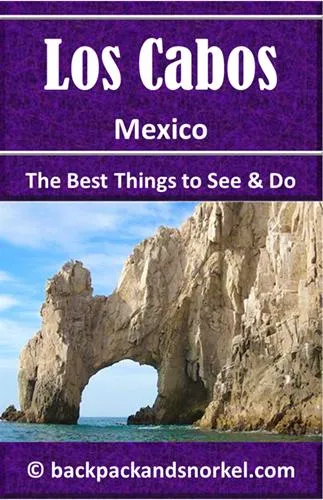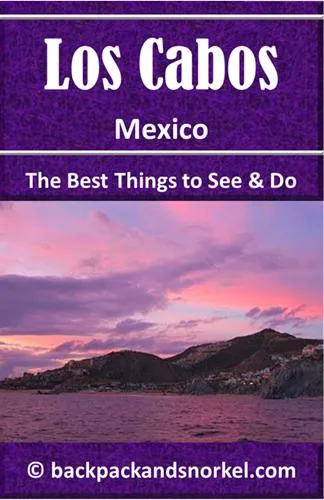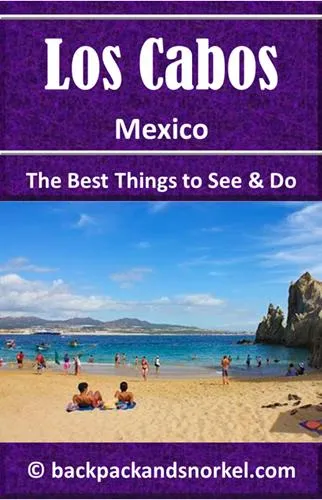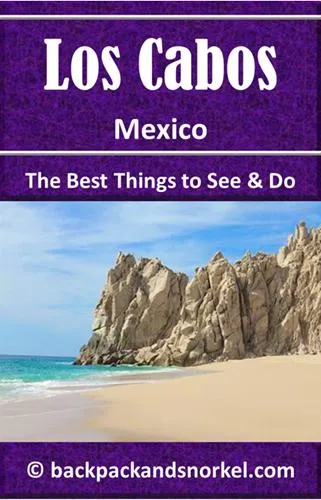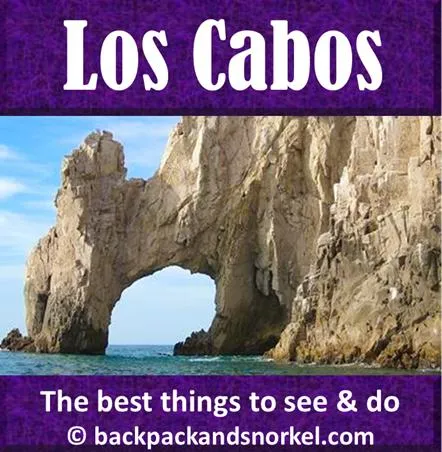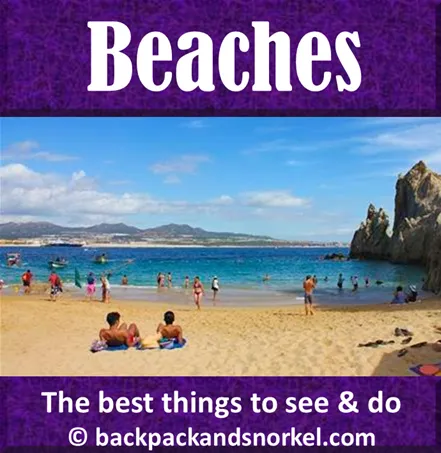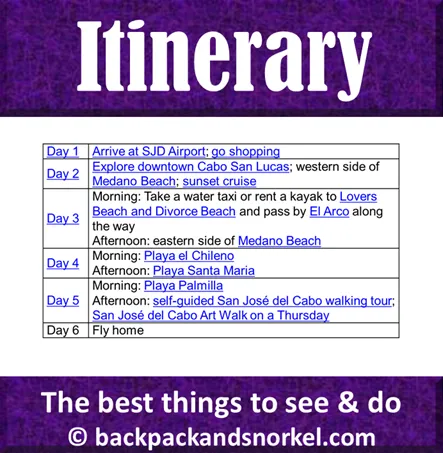Los Cabos Purple Travel Guide 2025: Your Ultimate Guide to Paradise
Los Cabos, located on the southernmost tip of Mexico’s Baja California Peninsula, is a very popular vacation and expat destination. People are drawn to Los Cabos for various reasons:
Beautiful scenery: From dramatic cliffs with quiet sandy beaches on the Pacific coast and the iconic Los Cabos arch (El Arco), to the serene beauty of the Sea of Cortez with excellent snorkeling spots, Los Cabos is a perfect vacation spot for nature enthusiasts, people seeking a serene experience, and party animals.
World-class resorts: Los Cabos is a vibrant vacation destination that features a wide array of accommodations, from rustic Airbnbs to all-inclusive luxurious resorts, offering exceptional amenities, impeccable service, and stunning oceanfront views.
Thrilling adventures: Whether you're an avid angler seeking a deep-sea fishing adventure, a wildlife enthusiast hoping to spot whales or hike mountainous terrain, an ATV enthusiast, or an underwater explorer eager to explore the vibrant marine life, Los Cabos offers a diverse range of exciting activities and nature experiences.
Exquisite cuisine: Los Cabos is a culinary paradise, where a fusion of Mexican flavors with international influences creates a vibrant and diverse food scene. And you can learn how to cook like a Mexican by attending a cooking class, or two.
Unwind in paradise: You can escape the everyday stress and relax on pristine beaches, immerse yourself in the gorgeous underwater world via snorkeling right off the beach or by boat, enjoy rejuvenating spa treatments, party on Medano Beach, or join the large international expat community. Los Cabos has something for everyone, making it the perfect destination for your next vacation.
Fantastic weather: Cabo San Lucas has a tropical desert climate with an average of more than 352 days without rain. And the temperature? The daily high is almost always above 77 F (25 C), and rarely exceeds 93 F (34 C). Can it get any better?
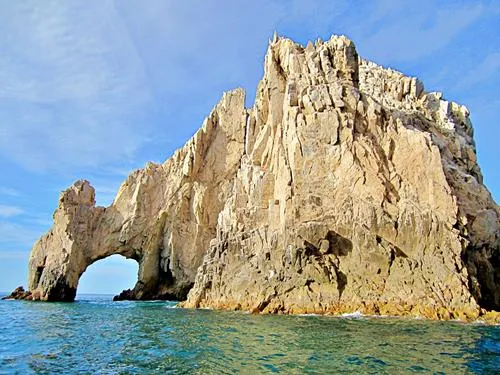
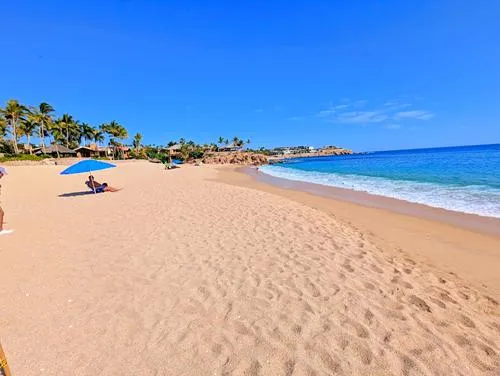
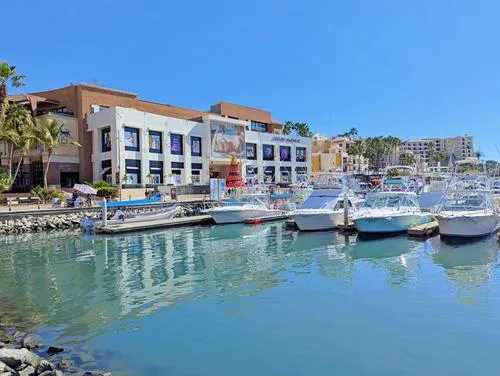
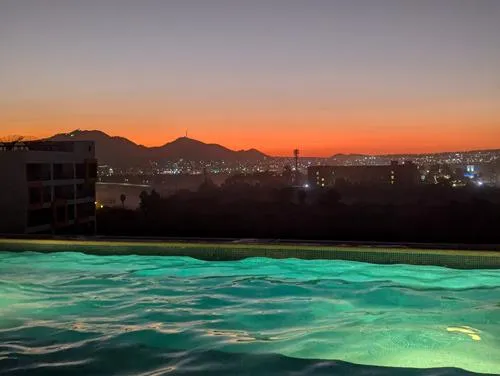
In this Backpack and Snorkel Los Cabos Purple Travel Guide, we provide you with a six-day itinerary for Cabo San Lucas and San Jose del Cabo (Los Cabos) that focuses on the best things to see and do in one of our favorite travel destinations.
Here at Backpack and Snorkel Travel Guides, we typically promote self-guided walking tours.
But we realize that not everybody likes to walk by themselves in a foreign city. So, just in case that you rather go with ab guide: NO PROBLEM! Please see the Viator tours below.
How much time do you need to visit Los Cabos?
Los Cabos is a wonderful vacation destination. If you just want to scout the area, then 3-4 days are sufficient.
We always recommend visiting nearby Todos Santos and La Paz. If you do that, then you would need at least 7 – 10 days.
And, if you want to add some relaxation, then you should reserve 2 or more weeks for your part in this paradise.
In this Los Cabos Purple Travel Guide, we present a six-day itinerary for Los Cabos that introduces you to the best places to see in Los Cabos. You can use it as is, or you can tailor it to your interests by prioritizing your favorite destinations and by visiting your favorite beach or resort for many days in a row.
You can find the 6 to 9-day Los Cabos itinerary here.
What is the best time to visit Los Cabos?
Cabo San Lucas has a tropical desert climate with an average of just below 13 days per year where any rain is registered.
Its dry season from December through April is the high season.
During the hurricane season from May through October, you will see some clouds and occasional rain. During that time, there is a chance of either being hit by a hurricane or being affected by nearby hurricanes, which can cause widespread flooding.
The best time to visit Los Cabos:
December – April: This is the peak tourist season in Los Cabos – the hotel and airfares rates are at their peak. These months are generally characterized by clear skies, little to no rain, and warm temperatures. The daily maximum is between 77 F (25 C) and 84 F (29C). Ocean temperatures in December are around 75 F (24 C), which some people feel is borderline for swimming, many feel it is too cold and need wetsuits. From January through April, the ocean temperature is a chilly 70 – 72 F (21 - 22 C).
High season coincides with whale watching season. You will see lots of whale watching tours being offered during that time.May – June: This is the Spring shoulder season. Hotel rates and airfares go down a bit and there are fewer tourists. The daily high temperature is 87 – 89 F (31 - 32 C), and the ocean temperature around 73 – 74 F (23 C), which is Ok for a short swim, but most people prefer wet suits for snorkeling tours or longer swims.
July – September: This is Los Cabos’s low season, and rainy season, which brings the benefit of the lowest prices of the year for airfare and hotels with it. Well, rainy season means that there is an average of 1-3 rainy days per month. This is also the time of year, where the chance of hurricane hits or chances of being affected by nearby hurricanes is the highest.
Hurricanes that have hit Los Cabos in the last 60 years that we are aware of are:Category 3 hurricane Odile in September 2014
Category 3 hurricane Kiko in September 1989
Category 3 hurricane Olivia in September 1967
The daily high temperature is typically around 92 F (33 C), and the ocean temperature a comfortable 78 F (25 C) – 85 F (29 C).
October – November: This is the Fall shoulder season, which sees tourist numbers slowly picking up after the low season. October still has a chance for some rain (on average 1 -2 rainy days per October), and could potentially even be affected by hurricanes, but that rarely happens. November is usually dry. Daily high temperatures are usually between 85 – 90 F (29 – 32 C), and the ocean temperature is at a comfortable 80 – 84 F (27 – 29 C).
Below is the climate that you can expect on your trip to Cabo San Lucas:

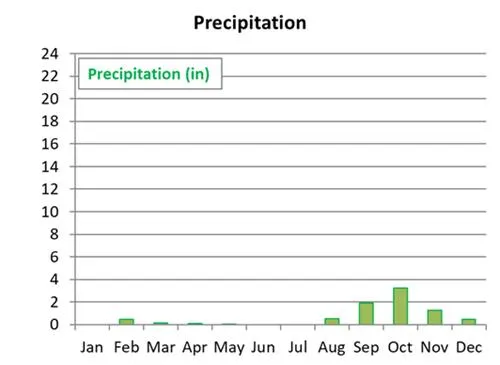
Below is the climate that you can expect on your trip to San Jose del Cabo:
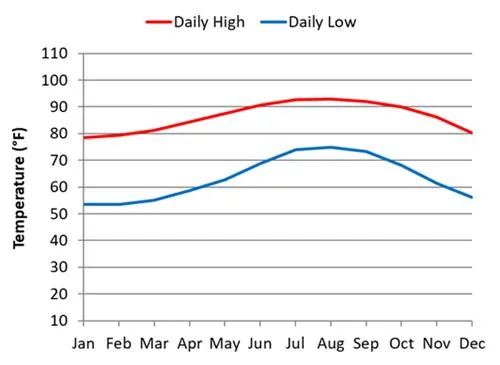
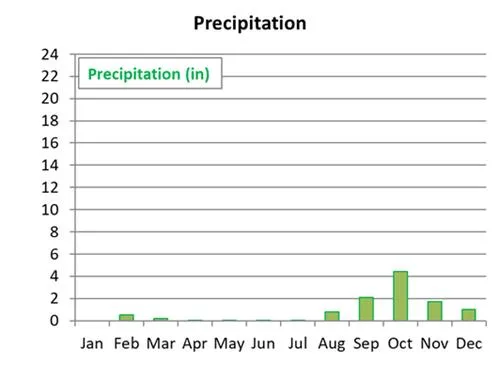
Below is the climate that you can expect on your trip to Todos Santos:
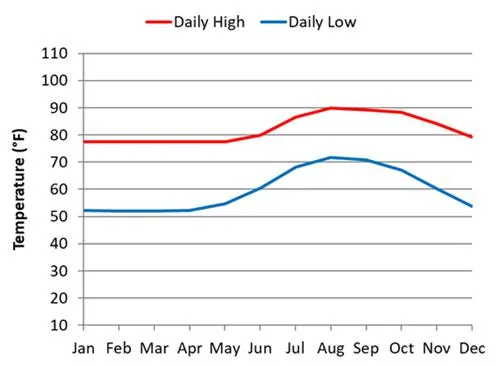
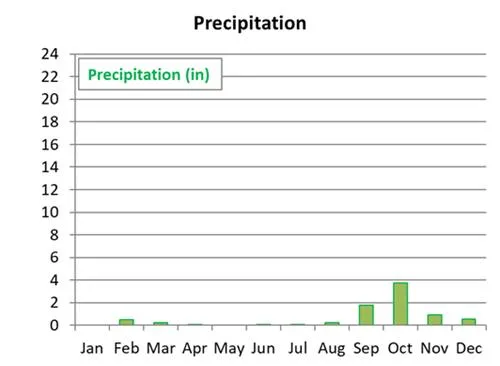
Highlights of the history of Los Cabos
8,000 BC: the Los Cabos area is inhabited by the Pericú people, who may have been here as early as 10,000 BC
1530s AD: first contact between Fortún Ximénez and mutineers from an expedition sent out by Hernán Cortés with the Pericú people
16th - early 18th century: sporadic contacts of the Pericú people with European explorers and privateers
1730: the Jesuit Misión Estero de las Palmas de San José del Cabo Añuití is founded in the outskirts of what is now San Jose del Cabo
1734: the Pericú revolt against the Jesuits leads to the deaths of 2 Jesuits, the destruction of the mission in San Jose del Cabo, and large numbers of Pericú deaths. Pericú continue dying from diseases brought by the Jesuits
1735–1736: a new fortified outpost in San Jose del Cabo is established closer to the ocean
1753: San Jose del Cabo is again moved inland
1768: the Pericú are extinct
1768: the Spanish crown expels the Jesuits from Baja California
1788: Cabo San Lucas is founded by Cipriano Ceseña who arrived from Hermosillo, and a fishing village starts to develop
1795: the Dominicans transfer from Mission Santiago (located about 25 miles (40 km) north) to San José del Cabo
1917: an American company builds a floating platform in Cabo San Lucas to catch tuna
1973: the Federal Highway 1, also called Carretera Transpeninsular (Transpeninsular Highway), is completed
1974: the Mexican government starts developing Cabo San Lucas into a major tourist destination. With little regulation outside of San Jose del Cabo, unchecked developments take place all over the Los Cabos area
How to get to Los Cabos
Most of the almost 4 million annual visitors arrive by plane at the Los Cabos International Airport (airport code SJD), which is located north of San Jose del Cabo.
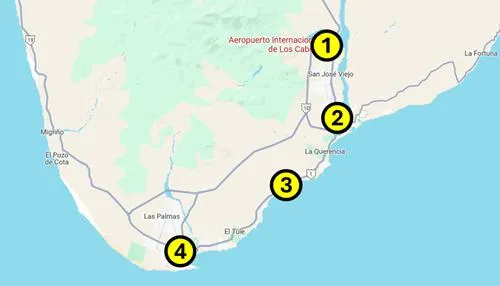
1 = Los Cabos International Airport
2 = San Jose Del Cabo
3 = Federal Highway 1
4 = Cabo San Lucas
The airport has invested in modern technology for customs and immigration, and unless you need a visa, you can now walk through the fully automated gates that scan your passport, take a photo of you, and then admit you to the country. And all that with no or almost no waiting in line. Fantastic!

Some guests arrive by cruise ship in Cabo San Lucas. As there is no cruise port, cruise ship passengers are transported to land on a tender (small boat).
Other visitors drive from various parts of Mexico to Los Cabos, and some people even make the long drive from the US to Los Cabos either in their own car or in a rental car.
Los Cabos and the entire Baja California Sur (BCS) peninsula are part of the so-called Mexico free/border zone. That means that drivers that enter BCS directly from the US only need the so-called Mexico insurance, but no TIP (Temporary Vehicle Import Permit). TIP is a mandatory permit that allows non-Mexican citizens to take a vehicle across the border into Mexico from other countries.
Should the vehicle leave the Mexico free/border zone at any time, then TIP is mandatory.
Please be advised that not having valid Mexico Insurance and or TIP when needed will get you in deep trouble with Mexican law and you may even be detained.
If you drive your own car, check with your car's insurance company for Mexico Insurance policies.
If you get a rental car, then make sure that your rental car company allows their cars to be taken into Mexico. Historically, Dollar, Hertz, Alamo, and Enterprise have allowed to take their cars into Mexico, and it is possibly that other rental car agencies allow that too. But you absolutely need to verify that this is true for your rental.
In all cases, you will have to buy the Mexico Insurance from the rental company. The cost for a mid-size car used to be approx. $25-$40 per day when we did that a few years ago, but is likely more expensive nowadays.
How to get around in Los Cabos
Unless you plan to stay at a resort for your entire vacation, or stay in walking distance to the beach in Cabo San Lucas, or you are fine with going anywhere by uber or taxi, you will need a rental car.
Cabo San Lucas and San Jose del Cabo are about 20 miles (32 km) apart and the best beaches are located in-between the two towns. You may also want to go shopping, and maybe explore nearby cities like Todos Santo, or La Paz. You will need a car for all that.
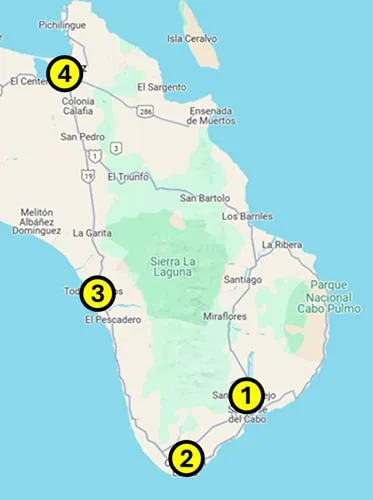
1 = San Jose Del Cabo
2 = Cabo San Lucas
3 = Todos Santos
4 = La Paz
All big international car rental companies and some local Mexican companies are at the Los Cabos International Airport (SJD). Renting and returning undamaged cars is quicker than in many other places in Mexico, and the personnel is used to speaking English.

Gas stations are plentiful, and you can pay by credit card. Just be advised that you are not allowed to pump your own gas – an attendant will do that.
Tell the attendant 'Lleno de premium por favor' (please fill up the tank with premium gasoline) and, if they wash your windshield or perform any other service, tip them 10 or 20 Pesos. The double 'L' in 'Lleno' is pronounced like a 'J' in English and the 'e' in 'Lleno' and 'premium' are pronounced like the second 'e' in 'behemoth'.
Parking in the center of San Jose del Cabo, and near the main touristy areas in Cabo San Lucas is usually difficult to find. But if you are willing to walk ¼ mile (400 m), then you can usually find a spot.
Parking near the popular beaches like Chileno Beach and Santa Maria Beach is often easy to find, unless you come in the high season in the late morning or early afternoon.
Important Information About Beaches in Los Cabos
Los Cabos is located where the Pacific Ocean and the Bay of Cortez meet. As with other towns on Mexico’s Pacific coast, swimming is only safe in designated swimming areas in protected bays. The Pacific Ocean often has strong currents and dangerous undercurrents that pull you out to sea, monster waves that slowly build over the ocean and, because there are no protective islands or other obstacles to deflect their power, every year they pull beach goers out into the ocean – never to be seen again. Regardless how hot the air temperature is, the water in the deeper parts of the ocean is cold limiting the time a person is able to survive.
Therefore: Never go into the water at beaches that are not designated swimming beaches. Many beaches have flags that tell you about the danger level. If there is no flag, then there is absolutely no safe swimming.
Here is what the flags mean:
Green flag: save for swimming
Yellow flag: be careful when you are in the water
Red flag: must stay out of the water
Black flag: beach is closed, you must leave
White flag: advises you to stay out of the water due to high amounts of jellyfish
Blue flag: this beach is Blue Flag certified, which is an international eco-label which indicates that the beach meets stringent criteria in four key areas:
Water Quality: Excellent water quality is maintained
Environmental Management: The beach is well-managed and environmentally conscious
Environmental Education: Efforts are made to educate the public about environmental protection
Safety & Accessibility: High safety standards are met, and the beach is accessible to people with disabilities
From the beaches that are mentioned in this Backpack and Snorkel Purple Travel Guide, the following beaches are designated swimming beaches:
Lovers Beach (Playa de los Amantes)
Medano Beach (Playa El Medano)
Chileno Beach (Playa El Chileno)
Santa Maria Beach (Playa Santa Maria)
Palmilla Beach (Playa Palmilla)
Just be advised to stay in the areas that are marked for safe swimming. If you swim outside those areas, then you risk becoming the victim of dangerous currents, or boats and jet skis. Boaters expect you to stay inside the marked areas, and may run you over without ever seeing you.
It is never (!) safe to go into the water at Divorce Beach (Playa del Divorcio).
Please note that google maps shows that Lovers Beach goes all the way from the northeastern landing spot with beach through the rock corridor to the Pacific Ocean. This is wrong! The entire Pacific oceanfront beach is Divorce Beach. Only the northeastern part is Lovers Beach.
If you are in doubt if you can go into the water at any beach, don’t go in the water, or ask a local.
Where do you want to go now?
Author: Rudy at Backpack and Snorkel
Bio: Owner of Backpack and Snorkel Travel Guides. We create in-depth guides to help you plan unforgettable vacations around the world.
Other popular Purple Travel Guides you may be interested in:
Like this Backpack and Snorkel Purple Travel Guide? Pin these for later:
